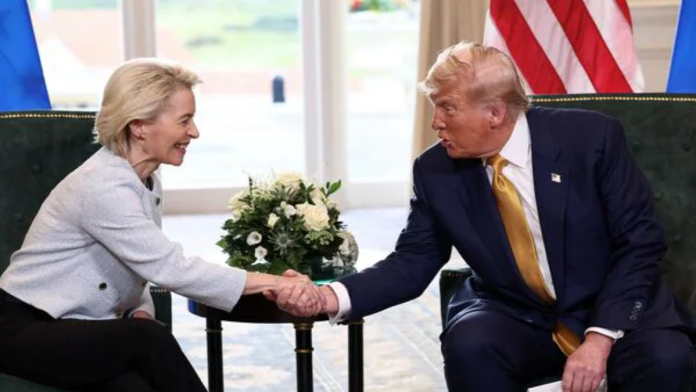A major economic crisis between the United States and the European Union has been narrowly avoided. In a high-stakes negotiation that ended just days before new tariffs were set to take effect, the two sides reached a hard-fought agreement. The deal, announced by U.S. President Donald Trump and European Commission President Ursula von der Leyen, sets a 15% tariff on most EU exports to the U.S., stopping a dangerous trade battle before it began.
Last-Minute Tariff Agreement Prevents Economic Shock
The agreement comes after months of tension and threats from both sides. President Trump had warned of tariffs as high as 50% on European goods. In response, the EU was preparing to strike back with duties on about €100 billion worth of American products. Both sides stood on the edge of a full-scale trade war — until the last-minute breakthrough.
The newly agreed 15% tariff will apply to a wide range of goods exported from the EU to the U.S. and will take effect on August 1. Items affected include automobiles, pharmaceuticals, and semiconductors — some of the EU’s most valuable exports. These products had been at the center of intense debate throughout the talks.
President Trump, speaking from his Turnberry golf resort in Scotland where the deal was announced, called it “the biggest of all the deals.” Von der Leyen added that it would bring “stability” and “predictability” to both economies.
💣 Tariffs could skyrocket past 100% if US-China talks fail in Stockholm – the world holds its breath
Key Details of the Deal
Under the final agreement, most EU exports to the U.S. will now face a flat 15% tariff. While Trump initially suggested that pharmaceuticals and metals would be excluded, von der Leyen later clarified that pharmaceutical products will indeed be included in the 15% rate. She also stated that the tariff would not be stacked on top of existing industry-specific duties, offering some relief to exporters.
For steel and aluminum, the current 50% tariffs will remain. However, a quota system will be introduced. This means that a limited amount of these metals can enter the U.S. at a lower tax rate, while any amount above that limit will still face full tariffs.
In exchange for these terms, the EU has made significant commitments:
- A pledge to buy $750 billion worth of U.S. energy products.
- A promise to invest an additional $600 billion in the American economy.
- An agreement to open EU markets for certain U.S. goods at zero tariffs.
- A deal to purchase large quantities of U.S. military equipment.
According to officials involved in the talks, these pledges were key to securing a lower, single-rate tariff on sensitive sectors like medicines and microchips. A separate investigation in the U.S. into pharmaceutical imports will not affect the EU’s agreed tariff rate.
EU declares tariff war on Norwegian alloys—200-day clampdown starts August 19
Averting a Full-Scale Trade War
The deal has been welcomed by several European leaders, including German Chancellor Friedrich Merz and Italian Prime Minister Giorgia Meloni, who both described the agreement as “sustainable.” Their responses show relief at avoiding what could have been a painful disruption to trade across the Atlantic.
The European Union had originally hoped to avoid tariffs altogether. But as Trump increased pressure — at one point threatening 50% tariffs on nearly all EU products — negotiators focused on getting the best possible terms. According to Stephen Olson, a former U.S. trade negotiator, the EU was always at a disadvantage in the talks. “The EU sees value in open trade relations; President Trump does not. That simple dynamic put the EU behind the eight ball,” he explained.
Despite agreeing to what some European industry groups called an “unbalanced” deal, EU leaders say it was the only way to prevent greater harm. Trade between the U.S. and EU involves over $1.7 trillion each year, and a tariff war could have affected everything from car prices to medicine supplies.
Talks are still ongoing for a few items, including wine, spirits, and aerospace products. These remain unresolved but are expected to be addressed in follow-up meetings. Meanwhile, steel and aluminum remain outside the new agreement’s lower rate and continue to face 50% duties, although subject to volume-based quotas.
With this agreement, both sides have taken a major step back from escalating conflict, setting the stage for more stable trade between two of the world’s largest economies.
